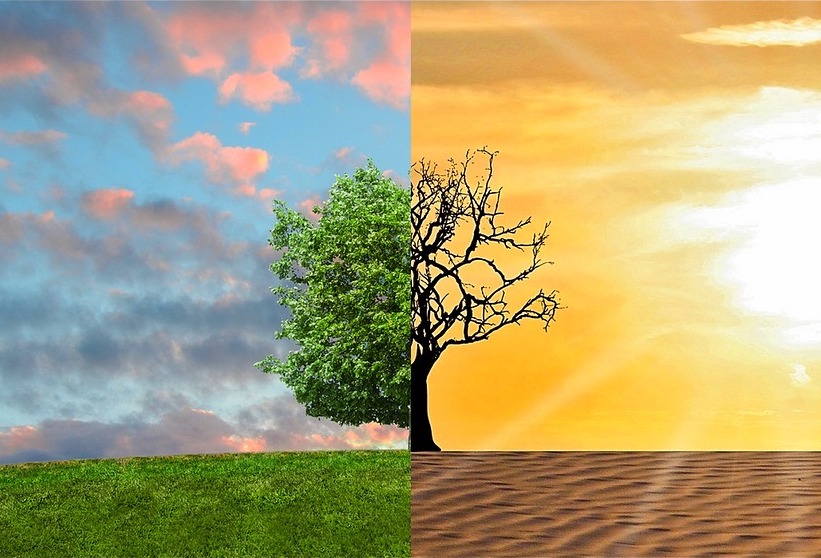
PAGE NAVIGATION
- Introduction
- Context
- Key Actors
- Social Media Presence
- Impact of the Movement
- Critiques of Movement
- Conclusion
Introduction
This chapter in the Berkeley Guide to Social Media and Social Movements pertains to the international #ClimateChange movement. Climate change is caused primarily by human activity and results in an increase in the average global temperature. From 1850 to the present day, global temperatures have risen significantly. This increase in global temperature has affected millions of lives, causing devastating natural disasters including wildfires, droughts, flood, mass migration, which will lead to regions of the world becoming uninhabitable.
The graph above illustrates the dramatic increase in global temperatures from 1880-2015. This rise in temperature follows the Industrial Revolution in Europe. As nations continued to industrialize rapidly and emit more greenhouse gas emissions, this exacerbated the greenhouse effect and caused the Earth’s temperature to rise at an increased rate.
Climate change affects the entire planet, occurring on all continents and the sea. However, certain groups are more vulnerable to the effects of climate change than others, especially under-developed nations with less stable infrastructure that cannot prepare for or recover from the natural disasters attributed to climate change. Although low-lying islands such as Mauritius are currently most at risk of experiencing sea level rise, India, Pakistan, the Philippines, and Bangladesh are the most vulnerable countries due to their reliance on agriculture, high sensitivity to extreme weather, exposure to energy transition risks, and their lack of ability to respond to climate change.

The 67 countries selected by an HSBC study as “most vulnerable” to climate crises made up 80% of the global population.[2]
These countries are more likely to suffer from malnutrition due to global food shortages, and resource control conflicts. A decrease in food supply and a rise in climate caused migration would affect more developed nations, as well. In turn, first-world countries with better infrastructure to protect against extreme weather, would be forced to experience the consequences of global economic and sociopolitical destabilization.[3]
As social media continues to replace news outlets in educating the public, Facebook, Twitter, Youtube, and other platforms are useful tools for shifting public opinion. Although climate change and its lasting effects caused by humans are demanding issues known around the world, our MoveMe chapter will seek to provide, in an unbiased format, a deeper understanding of how social media influence can rapidly accelerate the solving of modern environmental problems.
Key Terms:
Carbon dioxide – a gaseous compound which contributes to the greenhouse effect and which is one of the main causes of climate change. Carbon dioxide levels are increasing due to an increase in burning of fossil fuels, and a reduction of carbon sinks, such as rainforests, which can sequester atmospheric carbon dioxide and reduce the effects of it on the Earth’s ozone layer
Greenhouse gas – gases which allow more of the Sun’s radiation to enter the atmosphere and trap this radiation, causing less energy to be reflected off of the Earth. This warms up the planet
Weather – the short term conditions in the atmosphere, relating to temperature, humidity, precipitation, solar intensity, wind etc.
Climate – the average of weather patterns over a period of 30 or more years. In reference to climate change, the change, which is partially caused by greenhouse gas emissions, correlates with an increase in average temperatures over a long period of time, even though on a day-to-day basis, the weather might vary drastically
Renewable energy – energy which is generated through sources which naturally replenish themselves. Typically, renewable energy sources do not produce greenhouse gases, so do not contribute as heavily to climate change. For this reason, the climate change movement advocates switching to renewable sources of energy, rather than relying on non-renewables, to mitigate the effects of climate change.[4]
Symbols Associated with #ClimateChange:
The sad, starving polar bear is a popular symbol for the #ClimateChange movement, because it attracts sympathy from the public, so that activists are able to raise awareness about the issue. While it succeeds in attracting attention, particularly to the problem of loss of Arctic biodiversity, it has been criticized for only representing one aspect of climate change and doesn’t present a complete picture of the problem.[5]

The child with asthma is another symbol for the movement, especially in countries experiencing poor air quality. Like the polar bear, it is an emotional appeal, with the added impact of depicting a human being instead of an animal. In the US, one in ten children suffer from asthma, and it is a useful symbol, particularly for parents, to remind the public about the negative health consequences which people incur as a result of pollution from power plants. It was used extensively on social media in an effort to push for increased regulations on power plants.[6]
Context
History
Since the dawn of the industrial age, there have been concerns about increasing earth temperatures, and the impact human actions have on other ecosystems. This section will try to explain the origin of #ClimateChange, and how over the last century it has branched into multiple forms of activism and political conversations.
Before modern social media, the environmental impact of human “progress” was often ignored or seen as an obstacle in the path of human evolution. After years of research, the human impact leading to the destruction of habitats has become clear. However, changing the climate wasn’t always seen as detrimental to the global ecosystem. The first scientific research on human climate impact dates back to 1906, where prominent Swedish scientist Svante Arrhenius was convinced of the benefits caused by global warming. “We may hope to enjoy ages with more equable and better climates, especially as regards the colder regions of the earth”.[7] Modern scientific literature, on the other hand, clearly illustrates the disastrous effects of climate change on human and nonhuman life.
After five decades of anti-regulation emission standards, a shift in thought towards global warming started to form. Research by Dr. Gilbert Plass in 1956 on the dangers of rising temperatures was published in the American Scientist, and the theory of Greenhouse Gases started to form. “The rays of the sun pass through the transparent glass, but the outgoing energy (heat) from pants in the greenhouse cannot pass through. … the result that it is warmer inside than outside. The atmosphere acts like the glass of the greenhouse”.[9] Small changes in average global temperatures could have devastating impacts on the already fragile ecosystems we inhabit. This publication specifically recognized human activity in coal and oil exploitation as the main reason for rising temperatures. [10]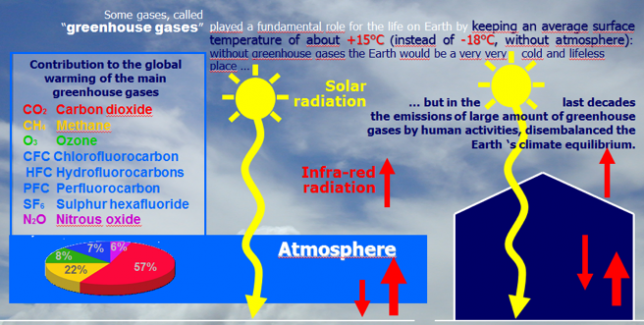
Due to the early 20th centuries industrial boom, minimally regulated corporations gained control of most sectors of human consumption. After many more years of silence about emissions, a wave of backlash against farming techniques emerged, specifically the use of DDT, in Rachel Carson’s Silent Spring (1962). DDT, used to treat a multitude of issues from head lice to agricultural insects, was found to cause major health problems in humans, as well as important animal cornerstone species.[11]
The 1970s started with a push for conservational activism, leading to the first nationally organized political protest against the changing global climate. The first annual Earth Day demonstrations took place on April 22, 1970 in hundreds of cities across the United States. This event brought out over 20 million Americans out to the streets; “for peaceful demonstrations in favor of environmental reform.”[12]
The widespread public support for environmental preservation promoted the establishment of the Environmental Protection Agency in 1970, where among many changes, the Federal Water Pollution Control Act of 1972, and the Endangered Species Act of 1974 were major steps forward in curbing the impact of industrial impacts on the natural world.
For years, the major player in the conservation conversation has been the Sierra Club, established in 1892. Based out of Oakland, CA the organization founded by John Muir has fought for a myriad of issues involving US natural lands and resources. The club grew steadily over the 20th century, with national outreach leading to many more conservationist victories, gaining public support and political influence. Conservation efforts may not directly contribute to the fight against climate change, but protecting natural lands across the U.S provides a safe space for ecosystems to flourish and potentially offset the effects of pollutants.[13]
Moving into the 2000’s, climate change efforts have spread into the mainstream media with controversy and responding activism. The first international legislation to promote the limitation of greenhouse gas emissions was passed in 1997, when the UN Kyoto Protocol was adopted by 23 countries including the United States. This commitment limited the emissions of six greenhouse gases. This agreement was ratified in Bonn, Germany, 2003.[14]
As the history of climate change opinion has evolved over the last century, the main challenge of simultaneously providing for a growing population and protecting the environment has long been approached in a manner that favors the short term needs and the desires of humanity over their environmental implications.
Timeline
April 22, 2000: Earth Day, marking first time the internet was used as the primary organization mechanism of an environmentally focused event. February 15, 2003: Anti-war protests; specifically, the largest international protest against combat in Iraq which was fueled by multiple nations’ desires to control oil exports. May 4, 2006: Al Gore releases a shocking documentary, An Inconvenient Truth, about the dangers of climate change. April 22, 2007: Largest earth day to date, with thousands of locations of simultaneous participation. September 21, 2014: People’s Climate March in New York with 400,000 participants. December 12, 2015: Adoption of the Paris Agreement – an international agreement that nations share a collective responsibility to reduce the effects of humanity on the environment. April 29, 2017: People’s Climate March with 200,000 participants. June 1, 2017: President Donald Trump Withdraws from the Paris Agreement. October 8, 2018: Special UN IPCC climate report noting the rising global temperatures. November 1, 2018: Fridays For Future Protests, inspired by Swedish climate activist Greta Thunberg, began internationally.
Key Actors
Greta Thurnberg @gretathurnberg
Greta, 16, is the leader of the recent UK school strikes, #FridaysForFuture, and has spoken at the EU parliament about the dangers of climate change on future generations.
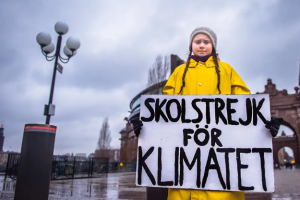
Emmanuel Macron @EmmanuelMacron
The current president of France has made diplomatic progress in his international Paris Agreement, as well as economic agreements with 20 corporations that will phase out their use of coal.
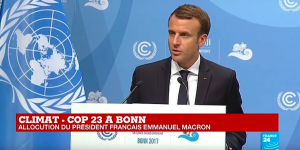
Pope Francis @Pontifex
Christianity’s foremost leader has publicly denounced climate change deniers, as well as urged governments around the world to limit their emissions in an attempt to slow climate change.

Naomi Klein @NaomiAKlein
Author and Journalist Naomi Klein published several books about climate change, including bestsellers No Is Not Enough and This Changes Everything, among others. She advocates fiercely against capitalism and its current detrimental effect on the global climate.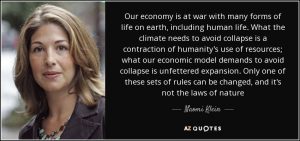 [27]
[27]
Leonardo DiCaprio @LeoDiCaprio
He established the Leonardo DiCaprio foundation, which supports wildlife projects around the world, joined the 2017 People’s Climate March and spoke at the United Nations on climate change and was on the board of several environmental organizations such as the WWF, International Fund for Animal Welfare and Global Green USA.[28]

The Politics of Climate Change
While science agrees that climate change is real, there are divides across the political spectrum in the US with regards to the acceptance of climate change. Overall, there is a strong partisan divide on the acceptance of climate change within the US, with the political left generally being more cognizant of the dangers of climate change. Nonetheless, the majority of people in every state in the US support regulating carbon emissions, and 71% of Americans and 57% of Republicans believe that the US should participate in the Paris Agreement.[30] [31]
On June 1st 2017, US President Donald Trump announced that the United States would withdraw from the 2015 Paris Agreement. He cited economic reasons for doing so, including the fact that it would damage the US economy and allow other countries like China and India to do nothing to cut their own emissions. However, since this announcement, no other country followed suit, and there has otherwise been strong momentum to meet global renewable energy and emissions targets. 7 US states have stated they will withhold the Agreement’s standards, and 20 House Republicans joined the bipartisan Climate Solutions Caucus, but overall the Republican Party has blocked efforts to repeal American climate policies.[32]
In addition, the hashtag #ClimateChange connects to the MoveMe chapter #NoDAP, a social media campaign to push back against the planned construction of the Dakota access pipeline across the Standing Rock Indian reservation. This is an example of how social media was successful in being used to mitigate climate change by allowing people to fight against projects which pollute the environment.
Social Media Presence
#ClimateChange is a well publicized movement, so climate activists have used nearly every popular social media platform to advocate for their cause. Twitter and Facebook are the most popular, due to their large user base. The ability of both of these platforms to spread video, images, and text increases their usability with respect to activism, compared to, Instagram, where text can only be posted in the form of a screenshot, or a caption where it blends seamlessly in with any comments made by other users.
Popular Hashtags
#ClimateChange – A blanket identifier used primarily to group together posts that are relevant to climate change in any form.
#ProtectOurWinters – A hashtag (and a social movement on in its own right) that highlights the effect of climate change on winter weather. It was started by outdoor recreation enthusiasts and companies since global warming could have a profound effect on winter activities such as skiing and snowboarding. It has several high profile supporters, including National Geographic and one of their top photographers, Jimmy Chin.
#FridaysForFuture[33] – A hashtag and movement that gained popularity in Sweden when a 16 year old schoolgirl protested the Swedish government’s inaction on climate change by sitting outside of the parliament building every weekday for three weeks. The hashtag has since gained popularity across Europe and advocates for school “walkouts” to protest activities or policies every Friday that contribute to or prevent the mitigation of climate change.
#ClimateChangeIsReal – Similar to #ClimateChange, this is somewhat of a general hashtag for posts pertaining to climate change, but it is also subtly politically charged. It takes aim at politicians and corporations that refuse to acknowledge or take action on climate change.
#EarthDay – A movement that started in 1970 where 20 Million people participated. It is a worldwide event that takes place every year on the 22nd of April. The day is used to strengthen our valuation of the natural environment and is intended to encourage people to think about their consumption behavior.
Influential Posts
This tweet by Donald Trump demonstrates his dismissive attitude towards climate change. It was retweeted nearly a hundred thousand times, by both supporters and critics. This is one of the 5 top tweets regarding climate change because of its popularity on social media, its coverage by mainstream television and online news outlets, and the popularity/political power of the man who wrote it.[34]
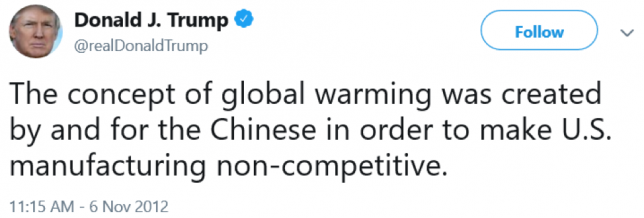
President Obama uses a casual basketball reference to lighten the mood of one of his popular tweets about Climate Change. The message is the literal opposite of the previous tweet, with Obama affirming the presence of climate change instead of denying it.[35]
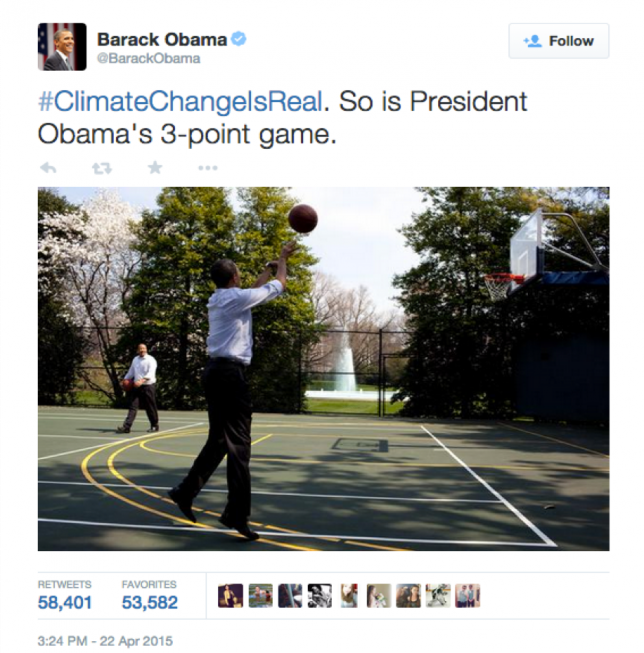
This image of a starving polar bear highlights the effects of climate change on wildlife. Due to the absence of ice and snow, this polar bear is in an extremely emaciated state and will likely not live much longer. This post, most likely because of its heart-wrenching sadness, has been liked roughly 1.7 million times on Instagram and circulated on online news media ever since it was posted in late 2017.[36]

Actor Leonardo DiCaprio is one of the most prominent climate activists today. Various social media analysis tools rank him as the top influencer for the #ClimateChange and #GlobalWarming hashtags.[37] In this tweet, he is voicing his support for the school walkout that has been promoted on social media via the FridaysForFuture hashtag.[38] DiCaprio has also issued direct calls to action to politicians regarding climate issue via his social media accounts, especially Twitter. Offline, he has attended numerous climate marches.

This Instagram post by Greenpeace highlights the effects of climate change on the Arctic. The powerful imagery and the creative photography of trying to replicate the first shot as accurately as possible add to the production value of this post. The large number of likes and comments earn this post a spot in the most influential climate change posts to date.

Memes vs Cause
The meme below uses sarcasm to suggest the plain stupidity of those who claim that climate change does not impact their lives.[39] While it may be argued that memes trivialize the catastrophic consequences of climate change, they also undoubtedly bring attention to the movement on social media platforms.

Russian trolls shared the tweet shown below to create cultural division between social media users in the US. This meme targeted the development of the Dakota Access Pipeline development, and mocked the supposed ‘destruction’ inflicted by climate activists while protesting against the pipeline.

Memes can be used to hit back against the climate change movement, as well as support it. However on the whole, they are a useful tool for convincing the public of the reality of climate. In general, they can lead to “synchronization of opinion”, and repeated viewing of them by social media viewers can lead to more attention being brought to the cause, and can shape the population’s views about climate change.[40]
Analysis of Social Media’s Role in this Movement
Social media is a vital tool in the campaign to bring awareness and action about climate change. It provides a space for everyone to discuss their concerns about the environment, and is effective in starting grass-root movements within the main #ClimateChange category, such as #FridaysForFuture. Facebook and Twitter are influential places for people to share ‘viral images’ and to recap their own personal experiences with climate change.
This spread of opinion on social media platforms are crucial for allowing society to bridge the knowledge gap between scientists and citizens. An informed public has the power to influence elections and policy changes that democratic societies are based on. Social media platforms also help citizens find out more about environmental laws and regulations implemented by their governments, allowing the public to pinpoint the problem and work towards finding a solution.
All in all, social media has allowed for the growth of this movement on an international scale, and put it on the radar of most governmental agendas.
Organic Growth vs Planned Growth
When analyzing the #ClimateChange movement in its entirety, it seems that most of the growth of the social media campaign happened organically, either as a result of extreme weather events or important events such as the signing of the Paris Climate Agreement in 2016.
However, certain segments of the movement, such as the “#FridaysForFuture” protests in Germany were planned. It was started by 16 year old Swedish Climate Activist, Greta Thunberg, who fought against the inaction of politicians in the face of the climate crisis. It was part of a plan to mobilize young people to take a stand against governments in fighting for climate change action.
Similarly, the #ProtectOurWinters hashtag was started by an organization, and is an example of a planned movement to advocate for climate change awareness. Other events, such as Hurricane Katrina and Maria were responsible for causing panic, which drew attention to the movement as a whole. So while planned segments of the movement were responsible for driving policy change and bridging the knowledge gap, organic growth based on world events had a more pronounced impact on people’s hearts and minds, instilling a sense of urgency that is vital for the movement’s success.
Offline Presence
Before and even during the advent of social media, the #ClimateChange movement had a strong offline presence. One example of an organization which engages in such action is the People’s Climate Movement, who rely on mass mobilization and have organized a series of physical protests about climate change across the US. They organized the 100 days of Mobilization protest in Spring 2017, and the Rise for Climate, Jobs and Justice movement in San Francisco in 2018.
While these events used online tools to organize people, their impact stemmed from the fact that a large number of people converged on a physical location to make their presence known. Additionally, scientists are constantly studying the effects of climate change in order to give the public more information to understand the intricacies of it. This scientific component of the climate change movement is crucial, as it is the basis for why humanity should be concerned about climate change to begin with.
Analog Antecedents
The most direct antecedents to the current climate change movement were the environmental movements of the mid and late twentieth century. Widely believed to have started in the 1960s and flourished in the context of counterculture during this time period, these movements were marked by people protesting the destruction of natural lands in the streets and physically preventing equipment from being used in activities that were detrimental to the environment, such as clearing large swaths of land.
This time period was also when ecological consciousness became mainstream, with artists and musicians weaving themes of environmentalism into their work. For example, Marvin Gaye’s song Mercy Mercy Me (The Ecology) brought attention to the dangers of chemical waste and nuclear radiation. [41]
Impact of Movement
The climate change movement is internationally very significant because it impacts our entire globe. More and more drastic changes are being experienced due to an increasing amount of natural disasters and extreme changes in weather. Therefore, the work done to prevent or reverse climate change is highly impactful, as well.
The #FridaysForFuture movement started off in Sweden and is now a global movement. During the Global Strike for Climate on March 15th, 2019, students in over 120 countries went on the street to protest for more climate action. Its spreading impact led to an increasing awareness of climate change, resulting in more people who are willing to participate in climate action. The movement gets support from Germany’s Chancellor; she sees the protests as a “very good initiative.”
The movement’s impact has shifted the Overton Window in the direction of global limitation of emissions and investment in renewable resources to sustain a growing population. Protecting the remaining natural landscapes, sacrificing cost and efficiency, and gathering international public support have propelled this movement, and will continue to do so until a sustainable future solution is reached. And example of this shift is the Green New Deal, which is receiving serious consideration in the United States. A proposal of that magnitude – a proposal that “radical” – would likely have been quickly dismissed a decade ago. However, one shortcoming of the movement is that the largest contributors to greenhouse gas emissions (generally oil and transportation companies) have been somewhat resistant to change since their business’s livelihood depends on actions that are majorly destructive to the environment. As such, the climate change movement’s effect on these companies has been limited. Additionally, transitioning to fully renewable energy on a global scale will not be feasible until the infrastructure to support the amount of energy that is currently being produced is comparable to the global oil/gas production infrastructure. While the political pressure from the climate change movement and the Overton Window effect can assist in this transition, a shift of that magnitude will inevitably be drawn out over an extended period of time.
However, one shortcoming of the movement is that the largest contributors to greenhouse gas emissions (generally oil and transportation companies) have been somewhat resistant to change since their business’s livelihood depends on actions that are majorly destructive to the environment. As such, the climate change movement’s effect on these companies has been limited. Additionally, transitioning to fully renewable energy on a global scale will not be feasible until the infrastructure to support the amount of energy that is currently being produced is comparable to the global oil/gas production infrastructure. While the political pressure from the climate change movement and the Overton Window effect can assist in this transition, a shift of that magnitude will inevitably be drawn out over an extended period of time.
While the #ClimateChange movement has not been as potent as was hoped for on the political front, innovators and private corporations are responding to market opportunities in an environmentally responsible manner. Significant progress has been made with regards to solar power, energy storage and micro-grid systems which use artificial intelligence a to improve efficiency. This has caused the price of renewable energy to drop dramatically across the globe, which has made it more feasible solution to the climate crisis. Investors can elect to hold a portfolio comprised entirely of environmentally responsible stocks or mutual funds, increasing the value of these sustainable companies and providing a financial incentive for lagging companies to “go green”.
Policy Achievements
Since the #ClimateChange movement began, several climate policy changes have occurred in the United States, including:
The Paris Climate Agreement: It built significant political and social momentum preceding the signing of Paris Climate Agreement in April 2016, which was signed by 194 countries which signed it. This represents 80% of global emissions. Countries agreed to reduce carbon dioxide and other greenhouse gas emissions, and took steps to pursue policies aimed at keeping the average global temperatures rise to under 2 degrees Celsius by the year 2100.- [42] [43]
The Clean Power Plan: President Barack Obama also put into place the Clean Power Plan, which mandates state specific carbon emissions regulations for fossil fuel power plants. This plan aims to cut carbon dioxide emissions by 32% from 2005 to the year 2030. However, President Donald Trump promised to roll back the plan, and it will likely be repealed by the current administration.- [44] [45]
Rejecting Construction of Keystone XL Pipeline: In 2015, President Obama rejected the request to build a 1,179 mile pipeline from Canadian oil sands to American coasts. This was done ahead of the Paris United Nations Summit meeting in December 2015. This action was said to be a symbolic victory for climate activists, who spent nearly four years rallying against the construction of the pipeline. President Obama was criticized fiercely by the Oil Industry and the Republican Party for listening to the demands of climate activists.[46]
Despite these landmark achievements, there are still significant strides which must be taken by the United States, and by the rest of the international community to mitigate the effects of calamitous effects of climate change. Furthermore, President Trump has proposed to the repeal the Clean Power Plan, signed an executive order to reverse Obama’s flood standards, withdrew from the Paris Agreement, and in March 2017, he stated that he would overturn fuel economy targets set by the Obama Administration.
While social media undoubtedly influenced US climate policy achievements by influencing politics, there is still a long way to go with regards to progress in this sphere. Political action under the current US administration is particularly limited, due to the administration’s anti-environmental stance.[47] #FridaysForFuture and #ClimateStrike movements are some the biggest influencers in political atmospheres, and we can assume that there will be policy changes in the next few years. In spite of Trump’s withdrawal from the Paris Agreement, the U.S. is trying to avoid more natural disasters by focusing and spending more on clean energy and green technologies.
Critiques of Movement
First, some feel that the more publicly prominent social media posts about climate change are more sensational than logical or scientific. For example, one report shows that, “overall, expert analysis of climate change is significantly absent from Twitter and Facebook discussions on climate change. Only 2% (Twitter) and 3% (Facebook) of shared content was scientific expert source material”.[48]
This is problematic, as it exposes the movement to questions about its factual validity. The #FridaysForFuture Movement received a lot of criticism because many students skipped school to protest for climate change. Every Friday students go on the street to protest for the movement and that’s seen as inappropriate by some politicians, such as the Australian Education Minister Dan Tehan, who said, “for action on issues that they think is important, they should do that after school or on weekends.”[49] The movement’s response to this criticism was based on the fact that formal education would be futile if the planet were to undergo massive changes due to climate change, justifying the students’ absence from school one day per week. The movement’s response to this criticism was based on the fact that formal education would be futile if the planet were to undergo massive changes due to climate change, justifying the students’ absence from school one day per week.
Other politicians don’t take the students’ grievances seriously, evidenced by a leader of a German party tweeting, “politics is for professionals.” Despite the significant amount of progress made in educating the public about climate change, there is intense skepticism about its validity. Nonetheless, an increasing percentage of the US population believes in the concept of climate change and more than 7 out of 10 Americans state that global warming is “personally important” in their lives.[50]
Another key point of criticism stems from accusations of hypocrisy at both the individual and corporate level. For example, it reflects poorly on the movement when climate activists are seen traveling around the world in high-emission vehicles such as private planes and yachts. In one noteworthy example, climate activist and actor Leonardo DiCaprio was seen traveling to accept an award for his environmental work on a private plane, At the corporate level, companies have been accused of hypocritical “virtue signaling” while still doing more to contribute to the climate crisis than to solve it. Additionally, activism organizations that are viewed as partnering too closely with such corporations are viewed as complicit in actions that directly conflict with the organization’s mission.
Conclusion
The climate change movement is still ongoing. Its origins can be traced back to Earth Day in 2000 but extensive action is still needed to reach its goal. Numerous campaigns and new movements have evolved since then and have ultimately led to the People’s Climate Movement, which is currently the largest modern climate change movement. They are planning more activities for the upcoming years, with the goal of reaching a larger audience than they have previously.[51]Analysis of Google Trends indicates that the topic of “Climate Change” is unlikely to lose popularity over the next several months.[52]
Over the last few years, social media has become an indispensable tool to discuss, inform and organize the movement. It helped to bring awareness around climate issues on both a national and global level, and connects people all across the world. Platforms like Facebook, Twitter and Instagram were used to spread the message, to bring more awareness to it, and teach the public about the world’s climate issues.
Social media has helped to bring awareness to the topic and issues that arise around climate change, but more actions are still needed to achieve change. The use of social media to achieve these goals will continue to be a major factor to gather support for the movement. When new issues arise, there are those who are willing to stand for the conservation of global resources, and those people are increasingly turning to social media to advance their cause.
Author Biography
Charlie Faramarzi
Charlie is a student studying EECS and Business Administration in the class of 2022 at UC Berkeley. Outside of school, Charlie has been involved in the management of an investment portfolio comprised entirely of environmentally responsible stocks and mutual funds.
Birks Sachdev
Birks is a student studying EECS and Business Administration in the class of 2022 at UC Berkeley. Prior to beginning his studies at UC Berkeley, Birks experimented with building solar technology, including a solar powered radio. He also worked for a civil engineering firm in London focusing on the construction of green buildings.
Mark Palmer
Mark is a student studying Integrative Biology in the class of 2019 with a focus in Integrative Human Biology. Prior to studying at UC Berkeley, Mark was involved in practicing Sports Medicine with local sports teams and Dental volunteer programs benefiting native Mayans in Guatemala. Mark plans to further his education in the field of Dentistry after graduating in the spring of 2019. As a member of the UC Berkeley Ski and Snowboard Team, I have a bias towards protecting annual snowfall, which correlates to rising global temperatures.
Anonymous
Anonymous is a student studying Interdisciplinary Studies Field (ISF) in the class of 2020 with a focus in Technology and Society. To get a further insight into the impact of social media on movements and how it shapes our society she decided to take a business course focusing on social media’s impact on social movements. Prior to her studies she interned at one of the Big Four’s and at a non-profit foundation of civil law where she worked in fields relating to media corporations, the finance sector and mentoring for sponsors.
Sources
[1] “Climate Change: An Introduction.” Campaign against Climate Change, 1 Mar. 2019, www.campaigncc.org/climate_change/introduction.
[2] Reuters. “Why India Is Most at Risk from Climate Change.” World Economic Forum, www.weforum.org/agenda/2018/03/india-most-vulnerable-country-to-climate-change.
[3] Goldenberg, Suzanne. “Climate Change: the Poor Will Suffer Most.” The Guardian, Guardian News and Media, 31 Mar. 2014, www.theguardian.com/environment/2014/mar/31/climate-change-poor-suffer-most-un-report.
[4] Skuce, Andy. “A Global Temperature Record for 2015.” Critical Angle, 20 Jan. 2016, critical-angle.net/2016/01/20/a-global-temperature-record-for-2015/.
[5] “Polar Bears and Climate Change: What This Symbol Is Missing.” Students for a Sustainable Stanford, studentsforasustainablestanford.weebly.com/blog/polar-bears-and-climate-change-what-this-symbol-is-missing.
[6] Woody, Todd. “Meet the New Symbol of Climate Change.” TakePart, 2 June 2014, www.takepart.com/article/2014/06/02/epa-limits-coal-emissions/.
[7] Fleming, James Rodger. Historical Perspectives on Climate Change. Oxford University Press, 1998.
[8] Rothman, Lily. “The Environment Used to Be a Non-Partisan Issue.” Time, Time, 2 Dec. 2015, time.com/4127200/epa-founded-1970/.
[9] Kaempffert, W. (1956). Science in Review: Warmer climate on Earth may be due to more carbon dioxide in the air. New York Times. New York: 191.
[10] “Mount Cimone GAW Global Station.” Greenhouse Gases | Italian Climate Observatory “Ottavio Vittori” @ Monte Cimone, www.isac.cnr.it/cimone/greenhouse_gases.
[11] Anderson, D, W.. “EFFECT OF DDT ON WILDLIFE”. Epidemiology, vol. 16, no. 5, September 2005, pp. S163-S164.
[12] “The Birth of EPA.” The Birth of EPA | EPA History | US EPA, web.archive.org/web/20060922192621/http://epa.gov/35thanniversary/topics/epa/15c.htm.
[13] “Sierra Club.” Facebook, www.facebook.com/SierraClub/.
[14] “Kyoto Protocol – Targets for the First Commitment Period.” UNFCCC, unfccc.int/process/the-kyoto-protocol.
[15] “Magic Mosaics – Earth Day 2000.” Magic Mosaics Earth Day 2000 Poster, www.magicmosaics.com/earthdaysample.html.
[16] Bennis, Phyllis. “February 15, 2003. The Day the World Said No to War.” Common Dreams, 15 Feb. 2013, www.commondreams.org/views/2013/02/15/february-15-2003-day-world-said-no-war.
[17] “An Inconvenient Truth.” IMDb, IMDb.com, 30 June 2006, www.imdb.com/title/tt0497116/.
[18] Admin. “How Did Leaders Respond to the People’s Climate March?” Climate Space, 26 Sept. 2014, climatespace2013.wordpress.com/2014/09/26/how-did-leaders-respond-to-the-peoples-climate-march/.
[19] Worland, Justin. “Donald Trump Paris Agreement Withdraw Would Challenge World.” Time, Time, 18 Apr. 2017, time.com/4723481/donald-trump-paris-agreement-withdraw/.
[20] Regan, Michael D. “’Science Is Crucial to the Future’ – March for Science Draws Thousands.” PBS, Public Broadcasting Service, 22 Apr. 2017, www.pbs.org/newshour/science/march-for-science.
[21] “Summary for Policymakers of IPCC Special Report on Global Warming of 1.5°C Approved by Governments.” IPCC Summary for Policymakers of IPCC Special Report on Global Warming of 15C Approved by Governments Comments, www.ipcc.ch/2018/10/08/summary-for-policymakers-of-ipcc-special-report-on-global-warming-of-1-5c-approved-by-governments/.
[22] “The Climate Kids Are Coming.” Atlas of the Future, atlasofthefuture.org/project/fridays-for-future/.
[23] “Climate Global Strike for Students LIVE – 15th March 2019.” Eudebates.tv, 15 Mar. 2019, www.eudebates.tv/debates/eu-policies/environment-energy/climate-global-strike-for-students-15th-march-2019/.
[24] Vaughan, Adam. “Greta Thunberg: Why I Began the Climate Protests That Are Going Global.” New Scientist, www.newscientist.com/article/mg24132213-400-greta-thunberg-why-i-began-the-climate-protests-that-are-going-global/.
[25] account, Emmanuel MacronVerified. “Emmanuel Macron (@EmmanuelMacron).” Twitter, Twitter, 23 Apr. 2019, twitter.com/emmanuelmacron?lang=en.
[26] Kelly, Cassie. “14 Notable Climate Influencers of 2017.” EcoWatch, EcoWatch, 26 Apr. 2018, www.ecowatch.com/climate-influencers-2017-2519436816.html.
[27] “TOP 25 QUOTES BY NAOMI KLEIN (of 99) | A-Z Quotes.” A, www.azquotes.com/author/8123-Naomi_Klein.
[28] Power, Team Arcadia. “10 Celebrities Leading Hollywood’s Fight Against Climate Change.” Blog, Arcadia Power, 17 July 2017, blog.arcadiapower.com/10-celebrities-leading-hollywoods-fight-climate-change/.
[29] “Telling the Story: Five Times Leonardo DiCaprio Spoke Out on Climate Change.” Climate Reality, www.climaterealityproject.org/blog/telling-story-five-times-leonardo-dicaprio-spoke-out-climate-change.
[30] “The World Is Moving On Since Trump Announced Intent to Withdraw From the Paris Agreement on Climate Change.” The World Is Moving On Since Trump Announced Intent to Withdraw From the Paris Agreement on Climate Change | World Resources Institute, www.wri.org/blog/2018/05/world-moving-trump-announced-intent-withdraw-paris-agreement-climate-change.
[31] Abraham, John. “Reflections on the Politics of Climate Change | John Abraham.” The Guardian, Guardian News and Media, 2 June 2017, www.theguardian.com/environment/climate-consensus-97-per-cent/2017/jun/02/reflections-on-the-politics-of-climate-change.
[32] “The World Is Moving On Since Trump Announced Intent to Withdraw From the Paris Agreement on Climate Change.” The World Is Moving On Since Trump Announced Intent to Withdraw From the Paris Agreement on Climate Change | World Resources Institute, www.wri.org/blog/2018/05/world-moving-trump-announced-intent-withdraw-paris-agreement-climate-change.
[33] “About #FridaysForFuture.” FridaysForFuture, www.fridaysforfuture.org/about.
[34] Trump, Donald J. “The Concept of Global Warming Was Created by and for the Chinese in Order to Make U.S. Manufacturing Non-Competitive.” Twitter, Twitter, 6 Nov. 2012, twitter.com/realDonaldTrump/status/265895292191248385.
[35] Obama, Barack. “#ClimateChangeIsReal. So Is President Obama’s 3-Point Game. Pic.twitter.com/M27bxCqJSG.” Twitter, Twitter, 22 Apr. 2015, twitter.com/BarackObama/status/591004613840543744.
[36] Person, and ProfilePage. “National Geographic on Instagram: ‘Photo by @CristinaMittermeier // This Is What a Starving Polar Bear Looks like. Weak Muscles, Atrophied by Extended Starvation Could…”.” Instagram, www.instagram.com/p/BceylHujELW/?hl=en.
[37] “#Climatechange: Popularity, Trend, Related Hashtags.” Hashtagify, hashtagify.me/hashtag/climatechange.
[38] DiCaprio, Leonardo. “I Stand in Solidarity with Those Who Participated in Yesterday’s Youth Organized Climate Strike. I Hope Everyone Is Inspired by This Movement to Continue to Address Climate Change.#FridaysForFuture.” Twitter, Twitter, 16 Mar. 2019, twitter.com/LeoDiCaprio/status/1106954333369700352.
[39] “CLIMATE CHANGE DOESNT MATTER IF YOU STAY INDOORS MEMEFULCOM | Change Meme on ME.ME.” Me.me, me.me/i/climate-change-doesnt-matter-if-you-stay-indoors-memefulcom-none-13177026.
[40] Yoder, Kate, and Kate Yoder. “Russian Trolls Shared Some Truly Terrible Climate Change Memes.” Grist, Grist, 2 Mar. 2018, grist.org/article/russian-trolls-shared-some-truly-terrible-climate-change-memes/.
[41] Movement.”, “Environmental. “Environmental Movement.” Dictionary of American History, Encyclopedia.com, 2019, www.encyclopedia.com/earth-and-environment/ecology-and-environmentalism/environmental-studies/environmental-movement.
[42] Lavelle, Marianne, et al. “2016: President Obama’s Climate Legacy Marked by Triumph, but Also Lost Opportunities.” InsideClimate News, 3 Jan. 2017, insideclimatenews.org/news/23122016/obama-climate-change-legacy-trump-policies.
[43] “Federal Policy on Climate Change, 2017-2020.” Ballotpedia, ballotpedia.org/Federal_policy_on_climate_change,_2017-2020.
[44] Lavelle, Marianne, et al. “2016: President Obama’s Climate Legacy Marked by Triumph, but Also Lost Opportunities.” InsideClimate News, 3 Jan. 2017, insideclimatenews.org/news/23122016/obama-climate-change-legacy-trump-policies.
[45] “Federal Policy on Climate Change, 2017-2020.” Ballotpedia, ballotpedia.org/Federal_policy_on_climate_change,_2017-2020.
[46] Davenport, Coral. “Citing Climate Change, Obama Rejects Construction of Keystone XL Oil Pipeline.” The New York Times, The New York Times, 6 Nov. 2015, www.nytimes.com/2015/11/07/us/obama-expected-to-reject-construction-of-keystone-xl-oil-pipeline.html.
[47] Ellsmoor, James. “2018: A Tipping Point for Climate Change.” Forbes, Forbes Magazine, 30 Dec. 2018, www.forbes.com/sites/jamesellsmoor/2018/12/30/2018-a-tipping-point-for-climate-change/#5cb4f04a6b8f.
[48] “Bulk of Social Media Content Supports Climate Change Research.” University of Oxford,
[49] Deutsche Welle. “Fridays for Future: Students Hold International Climate Change Protests | DW | 15.03.2019.” DW.COM, www.dw.com/cda/en/fridays-for-future-students-hold-international-climate-change-protests/a-47927393.
[50] Meyer, Robinson. “The Unprecedented Surge in Fear About Climate Change.” The Atlantic, Atlantic Media Company, 23 Jan. 2019, www.theatlantic.com/science/archive/2019/01/do-most-americans-believe-climate-change-polls-say-yes/580957/.
[51] “Our Plan.” Peoples Climate Movement, peoplesclimate.org/our-plan/.
[52] Google Trends, Google, 1 May 2019, trends.google.com/trends/explore?geo=US&q=/m/0cs9q .


